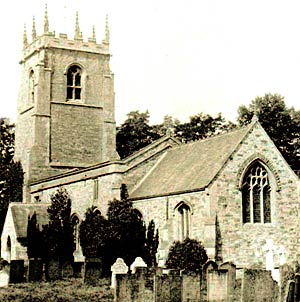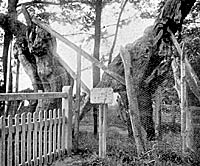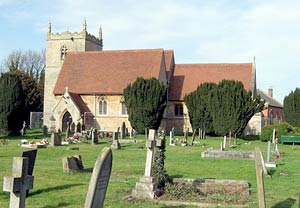< Previous | Contents | Next >
The Church Between the Villages

North and South Clifton church in the 1920s.
CLIFTON. It is Clifton North and South, a mile apart, each having a long shady lane between it and a fine stretch of the Trent, and both sharing a pleasing old church standing between them, near the river and the long line of arches on which the trains run.
A screen of fine elm, beech, and fir trees climbs as high as the eight tall pinnacles crowning the splendid tower, which is chiefly 15th century with some remains of the 13th; in its west doorway hangs a worn old door, and its fine arch to the nave is adorned with shields and embattled capitals. A porch made new and a 13th century doorway lead into the nave, where a beautiful arcade has 13th century arches resting on massive Norman pillars. The 500-year-old chancel arch has sides and carved capitals two centuries older. Worn heads adorn the hoods of the windows (many of which are 15th century), an old chest is like a trunk, and there are some old timbers in the aisle roof. Stone heads of kings and a queen support the modern roof of the chancel, which has a cornice of vine and grape.
The oak reredos, elaborate with paint and gilt, shows the Nativity.
The old piscina is like a tiny font, its round bowl on a tapering shaft and set in a rounded niche; and very quaint is an old image bracket in the aisle, carved with flowers and a cat-like face with its tongue out and its pointed ears upright; seeming to watch us come and go.
King's Palace and Parliament Oak
![The remains of King John's Palace in [Kings] Clipstone, 2003.](../../images/clipstone/clipstonepalace2003v1.jpg)
The remains of King John's Palace in [Kings] Clipstone, 2003.
CLIPSTONE. Part of a storied countryside, it sees the glories of the Forest as it lies in the valley of the Maun. The fine meadows through which the river flows, at the foot of the village, are famous for having been reclaimed from swamp and heath and gorse by the irrigation canal built to distribute the waters of the stream. Known as the Flood Dyke, it stretches nearly from Mansfield to Ollerton, passing through Clipstone.
In a cornfield above the small iron church are the scant ruins of what was a great building long ago. Still dignified by the name of King John's Palace, the rough grey walling, with jagged openings once doorways and windows, is impressive in the suddenness with which it rises against the sky as we see it from a narrow lane. It is said that kings of Northumbria built it and lived here. It was built at any rate before the time of King John, who used it as a hunting lodge. Henry the Second improved it and gave it a park. An English and a Scottish lion met here when Richard Lionheart talked with William the Lion on his return from the Crusades in 1194. Edward the First held a Parliament at Clipstone in 1290. The building began to decay in the time of Henry the Fourth.

The Parliament Oak, c.1910.
Two miles away, in a grassy bay of the road to Mansfield, are the remains of another vanished glory—the lifeless fragments of the gnarled and twisted trunk of an ancient oak, supported by props and fastened by chains to a younger oak. It is called the Parliament Oak, because Edward is thought by some to have held his parliament here and not at the palace. Another story is that by this tree King John (who was staying at his hunting lodge at the time) had a meeting with his nobles after hearing the news which led to the execution of 28 Welsh youths at Nottingham Castle.
Between Clipstone and Edwinstowe is a fine Gothic archway known as the Duke's Folly or the Duke's Archway, built by his Grace of Portland in 1842 after the style of the old Priory Gatehouse at Worksop. With buttressed walls, and rooms with traceried windows on each side of the central arch, it breathes the spirit of the Forest in the splendid figures niched on its north and south sides, and the stone hares that sit above the projecting bays. Richard the First is here in chain armour, with unsheathed sword; Friar Tuck with folded arms looking quizzically down; Allen-a-Dale with his harp; charming Maid Marian; Robin Hood himself with a feather in his cap, and Little John, like Robin, with his bow and quiver of arrows.
The arch looks one way to Clipstone, the other along an undulating grassy stretch, lined with oaks, running straight as the crow flies to the Mansfield road. It is said that the duke meant this broad turf ride to be part of a direct drive from Welbeck to Nottingham, passing through his Archway.
Prince Rupert's Strategy
CODDINGTON. From miles around we see the windmill of this pleasant red-roofed village on a hill, part of which Walter de Maresco received in the time of Henry the Third for giving the king a pair of scarlet breeches every year. With Beacon Hill close by, it has seen stirring times in days gone by, and shared in one of the most brilliant exploits of the Civil War.
It was in 1644, when Newark was besieged by 8500 Roundheads and was almost on the point of surrender, that Prince Rupert was sent to its help by Charles Stuart. The prince drew up his men at Coddington, and, rushing down Beacon Hill, delivered a rapid attack which so surprised the enemy that the town was saved. Two years later, during the final siege of Newark, some of the Roundheads were quartered in the village.

Coddington church.
© Copyright Derek Voller and licensed for reuse under this Creative Commons Licence
Eight fine pinnacles crown the low church tower, which rises above the steep red roofs of nave and aisle, and is, like the rest of the building, much renewed. It is a wide and pleasant place, entered by the enriched 13th century doorway inside a modern porch. The nave arcades are 13th century, the north a little older than the south. There are stone seats round the pillars of both arcades. The font is 700 years old.
The modern chancel has a wagon roof painted in medieval colours with much gold. The traceried panelling of the sanctuary walls, and the reredos with roses among its carving, are adorned in similar style. Very beautiful are the oak sedilia with a coved canopy and a rich cornice. The lofty chancel screen, with gilded tracery and four figures of bishops, was one of the gifts of the Thorpes, who have been benefactors to church and village. One was John Somerled Thorpe who fought in the South African War and fell on the Somme in 1916, and attached to his memorial here are his three actual medals, including the MC. Among so much that is new in woodwork a little old is treasured in six traceried bench-ends.
With the farm buildings close to the churchyard is a gabled dovecot, one of the oldest in the county, and used now as a little house.
